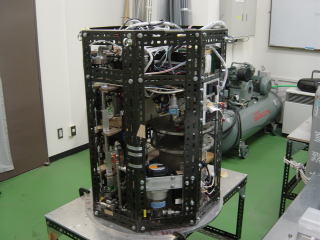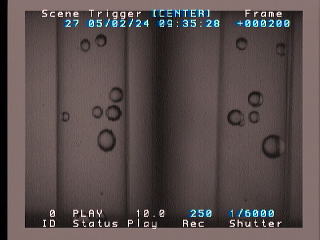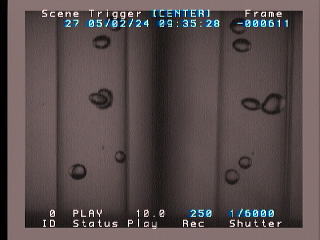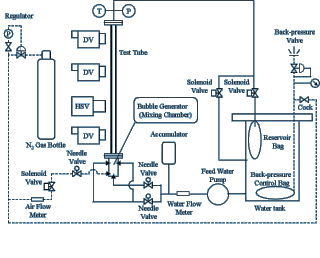





The two-phase flow experiments were performed at normal and microgravity conditions using an underground drop shaft at the Micro-Gravity Laboratory of Japan(MGLAB).The MGLAB drop shaft facility has high performances such as free-fall depth (100m), duration of microgravity (about 4.5s) and negligible residual gravity of under 10-5g. Abobe figure shows schematic diagram of a flow loop. The flow loopwas installed in a drop capsule of the MGLAB facility. The test section was a round pipe made of an acrylic resin. Its inner diameter D is 9.0mm. Nitrogen gas and pure water were supplied to the test section through mixing chamber. The flow measurements were performed by a Stereo-imaging-method with three digital video cameras placed at z/D = 5, 40, and 60 and a high-speed video camera placed at z/D =20.
Normal gravity
Microgravity

Above pictures show typical images of obtained data at normal gravity and microgravity. The bubble shape at microgravity conditions is almost sphrical.
In a thermal system of spacecraft, two-phase flow system now is an excellent
alternative to the conventional single-phase system in transporting large
amount of thermal energy at a uniform temperature regardless of variations
in the heat loads. In addition, two-phase flows exist in a wide range of
applications and enabling techmologies in space.
In view of the great importance of two geometrical parameters such as void
fraction and interfacial area concentration to the accurate two-phase flow
analysis at microgravity conditions, this study aims at the measurements
of the axial developments of flow parameters void fraction, interfacial
area concentration, bubble Sauter mean diameter, and bubble number density
at microgravity. The measurements were also performed in similar flow conditions
at normalgravity. The transport mechanisms of the flow parameters are discussed
in detail based on the data measured at normal and microgravity conditions,
and the drift-flux model developed at microgravity are compared with the
measured data.
